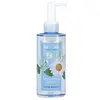What's inside
What's inside
 Key Ingredients
Key Ingredients

 Benefits
Benefits

 Concerns
Concerns

 Ingredients Side-by-side
Ingredients Side-by-side

Ethylhexyl Palmitate
EmollientIsohexadecane
EmollientSorbeth-30 Tetraoleate
EmulsifyingPropylene Glycol Dicaprylate/Dicaprate
EmollientIsopropyl Palmitate
EmollientCaprylic/Capric Triglyceride
MaskingIsododecane
EmollientEthylhexyl Pelargonate
EmollientCalendula Officinalis Flower Extract
MaskingSimmondsia Chinensis Seed Oil
EmollientMacadamia Ternifolia Seed Oil
EmollientCarthamus Tinctorius Seed Oil
MaskingPolyglyceryl-10 Dioleate
EmulsifyingPentaerythrityl Tetra-Di-T-Butyl Hydroxyhydrocinnamate
AntioxidantWater
Skin ConditioningTocopheryl Linoleate
AntioxidantButylene Glycol
HumectantCeramide AP
Skin Conditioning1,2-Hexanediol
Skin ConditioningParfum
MaskingEthylhexylglycerin
Skin ConditioningEthylhexyl Palmitate, Isohexadecane, Sorbeth-30 Tetraoleate, Propylene Glycol Dicaprylate/Dicaprate, Isopropyl Palmitate, Caprylic/Capric Triglyceride, Isododecane, Ethylhexyl Pelargonate, Calendula Officinalis Flower Extract, Simmondsia Chinensis Seed Oil, Macadamia Ternifolia Seed Oil, Carthamus Tinctorius Seed Oil, Polyglyceryl-10 Dioleate, Pentaerythrityl Tetra-Di-T-Butyl Hydroxyhydrocinnamate, Water, Tocopheryl Linoleate, Butylene Glycol, Ceramide AP, 1,2-Hexanediol, Parfum, Ethylhexylglycerin
Paraffinum Liquidum
EmollientMacadamia Integrifolia Seed Oil
Skin ConditioningPEG-20 Glyceryl Triisostearate
EmollientCetyl Ethylhexanoate
EmollientPEG-10 Isostearate
EmulsifyingWater
Skin ConditioningCarthamus Tinctorius Seed Oil
MaskingSimmondsia Chinensis Seed Oil
EmollientAnthemis Nobilis Flower Water
MaskingC12-15 Alkyl Benzoate
AntimicrobialIsohexadecane
EmollientIsopropyl Myristate
EmollientDicaprylyl Carbonate
EmollientTocopheryl Acetate
AntioxidantTocopherol
AntioxidantBHT
AntioxidantDehydroacetic Acid
PreservativeParfum
MaskingLimonene
PerfumingLinalool
PerfumingHexyl Cinnamal
PerfumingBenzyl Benzoate
AntimicrobialBenzyl Alcohol
PerfumingParaffinum Liquidum, Macadamia Integrifolia Seed Oil, PEG-20 Glyceryl Triisostearate, Cetyl Ethylhexanoate, PEG-10 Isostearate, Water, Carthamus Tinctorius Seed Oil, Simmondsia Chinensis Seed Oil, Anthemis Nobilis Flower Water, C12-15 Alkyl Benzoate, Isohexadecane, Isopropyl Myristate, Dicaprylyl Carbonate, Tocopheryl Acetate, Tocopherol, BHT, Dehydroacetic Acid, Parfum, Limonene, Linalool, Hexyl Cinnamal, Benzyl Benzoate, Benzyl Alcohol
Ingredients Explained
These ingredients are found in both products.
Ingredients higher up in an ingredient list are typically present in a larger amount.
Carthamus tinctorius seed oil comes from safflower, one of humanity's oldest crops.
Safflower seed oil contains a high percentage of linoleic acid and oleic acid. It also contains Vitamin E. These three components are effective moisturizers.
Vitamin E helps nourish your skin's lipid barrier. It is also a potent antioxidant. Antioxidants help fight free-radical molecules, or unstable molecules that may damage your skin cells.
Due to its high fatty acid content, this ingredient may not be malassezia folliculitis safe.
Thoughout history, safflower has been used for dying fabrics and in food as a saffron substitute.
Learn more about Carthamus Tinctorius Seed OilIsohexadecane is added to enhance texture, emulsify, and to help cleanse. It is an isoparrafin. It is a component of petrolatum.
Due to its large size, Isohexadecane is not absorbed by the skin. Instead, it sits on top and acts as an emollient. Emollients help keep your skin soft and smooth by trapping moisture within.
Isohexadecane is often used in products designed to help oily skin. It is lightweight and non-greasy while helping to moisturize. When mixed with silicones, it gives a product a silky feel.
Learn more about IsohexadecaneParfum is a catch-all term for an ingredient or more that is used to give a scent to products.
Also called "fragrance", this ingredient can be a blend of hundreds of chemicals or plant oils. This means every product with "fragrance" or "parfum" in the ingredients list is a different mixture.
For instance, Habanolide is a proprietary trade name for a specific aroma chemical. When used as a fragrance ingredient in cosmetics, most aroma chemicals fall under the broad labeling category of “FRAGRANCE” or “PARFUM” according to EU and US regulations.
The term 'parfum' or 'fragrance' is not regulated in many countries. In many cases, it is up to the brand to define this term.
For instance, many brands choose to label themselves as "fragrance-free" because they are not using synthetic fragrances. However, their products may still contain ingredients such as essential oils that are considered a fragrance by INCI standards.
One example is Calendula flower extract. Calendula is an essential oil that still imparts a scent or 'fragrance'.
Depending on the blend, the ingredients in the mixture can cause allergies and sensitivities on the skin. Some ingredients that are known EU allergens include linalool and citronellol.
Parfum can also be used to mask or cover an unpleasant scent.
The bottom line is: not all fragrances/parfum/ingredients are created equally. If you are worried about fragrances, we recommend taking a closer look at an ingredient. And of course, we always recommend speaking with a professional.
Learn more about ParfumThis oil comes from the seeds of the desert shrub called Jojoba. It is more commonly known as jojoba oil, a non-comedogenic oil.
Jojoba oil does not contain fragrance and has many fatty-acids, making it a great soothing ingredient.
It also contains Vitamin E, a great moisturizing ingredient. Vitamin E is also an antioxidant and protects your skin against oxidative damage.
This ingredient humectant properties, meaning it helps draw moisture from the air. This helps keep your skin hydrated.
While jojoba has antibacterial properties, it is only able to kill some strains of bacteria.
Studies also show it helps in wound healing. In fact, Indigenous cultures have used jojoba as a moisturizer and to help treat burns for centuries.
Fun fact: Jojoba oil similar to natural human skin sebum, so it has a great effect on dry skin. It is also promising with helping to regulate sebum production.
Due to its fatty acid content, Jojoba oil may not be fungal acne safe. We recommend speaking with a professional if you have any concerns.
Learn more about Simmondsia Chinensis Seed OilWater. It's the most common cosmetic ingredient of all. You'll usually see it at the top of ingredient lists, meaning that it makes up the largest part of the product.
So why is it so popular? Water most often acts as a solvent - this means that it helps dissolve other ingredients into the formulation.
You'll also recognize water as that liquid we all need to stay alive. If you see this, drink a glass of water. Stay hydrated!
Learn more about Water